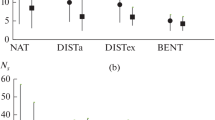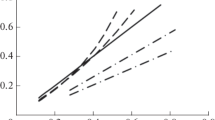Abstract
The question of the nature (random or ordered) of the loss of species in plant communities as a result of an increase in the participation of dominants is considered. The objects of study were 15 sites of communities of different types: riverbanks, forest meadows, steppes, subalpine and alpine meadows of the Western Caucasus, macrophytobenthos of the Sea of Azov. Two approaches were used: in the 1st one, the data on biomass samples taken from micro-sites of communities with differing participation of dominant species were compared with series of model cenoses with a random distribution of species; in the 2nd, groups of samples were compared with differing participation of the dominant, but with equal total biomass of accompanying species due to the different numbers of samples in groups. As a result, a well-pronounced effect of ordered disappearance of species was revealed only in three areas (dominated by Rubus caesius, Glycyrrhiza glabra, and Solidago сanadensis). In other cases, the distribution of species over micro-sites with differing participation of the dominant was random. This means that the increase in the participation of dominants leads mainly to an indiscriminate displacement of other species.


Similar content being viewed by others
REFERENCES
Hillebrand, H., Bennett, D.M., and Cadotte, M.W., Consequences of dominance: a review of evenness effects on local and regional ecosystem processes, Ecology, 2008, vol. 89, no. 6, pp. 1510–1520.
Hejda, M., Pysek, P., and Jarosik, V., Impact of invasive plants on the species richness, diversity, and composition of invaded communities, J. Ecol., 2009, vol. 97, pp. 3393–3403.
Somodi, I., Viragh, K., and Podani, J., The effect of the expansion of the clonal grass Calamagrostis epigejos on the species turnover of a semi-arid grassland, Appl. Veget. Sci., 2008, vol. 11, no. 2, pp. 187–194.
Mirkin, B.M. and Naumova, L.G., Sovremennoe sostoyanie osnovnykh kontseptsii nauki o rastitel’nosti (Basic Concepts of the Science of Vegetation: Current State), Ufa: Gilem, 2012.
Csergő, A.M., Demeter, L., and Turkington, R., Declining diversity in abandoned grasslands of the Carpathian Mountains: Do dominant species matter?, PLoS One, 2013, vol. 8, e73533.oi:10.1371..
Bartha, S., Szentes, Sz., Horváth, A., et al., Impact of mid-successional dominant species on the diversity and progress of succession in regenerating temperate grasslands, Appl. Veget. Sci., 2014, vol. 17, no. 2, pp. 201–213.
Elumeeva, T.G., Onipchenko, V.G., and Weger, M.J.A., No other species can replace them: Evidence for the key role of dominants in an alpine Festuca varia grassland, J. Veget. Sci., 2017, vol. 28, pp. 674–683.
Akatov, V.V., Akatova, T.V., and Chefranov, S.G., The relationship of dominance and evenness with productivity and species richness in plant communities with different organization models, Russ. J. Ecol., vol. 49, no. 4, pp. 296–305.
Rejmanek, M., Richardson, D.M., and Pysek, P., Plant invasions and invasibility of plant communities, in Vegetation Ecology, 2n ed., van der Maarel, E. and Chichester, J.F.Eds., Wiley, 2013, pp. 387‒424
Rejmanek, M. and Stohlgren, T.J., Scale-dependent impacts of invasive species: A reply to Chase et al. (2015), Biol. Lett., 2015, vol. 11, Art. 20150402. https://doi.org/10.1098/rsbl.2015.0402
Powell, K.I., Chase, J.M., and Knight, T.M., A synthesis of plant invasion effects on biodiversity across spatial scales, Am. J. Bot., 2011, vol. 98, no. 3, p. 539.
Powell, K.I., Chase, J.M., and Knight, T.M., Invasive plants have scale-dependent effects on diversity by altering species–area relationships, Science, 2013, vol. 339, pp. 316–318.
Akatov, V.V., Akatova, T.V., and Chefranov, S.G., Degree of dominance and species richness in plant communities with high and low intensity of interspecies competition, Biol. Bull. Rev., 2018, vol. 8, no. 6, pp. 389–400.
Solan, M., Cardinale, B.J., Downing, A.L., et al., Extinction and ecosystem function in the marine benthos, Science, 2004, vol. 306, pp. 1177–1180.
Gross, K. and Cardinale, B.J., The functional consequences of random vs. ordered species extinctions, Ecol. Lett., 2005, vol. 8, pp. 409–418.
Veselkin, D.V. and Dubrovin, D.I., Diversity of the grass layer of urbanized communities dominated by invasive Acer negundo, Russ. J. Ecol., vol. 50, no. 5, pp. 413–421.
Onipchenko, V.G., Semenova, G.V., and van der Maarel, E., Population strategies in severe environments: alpine plants in the Northwestern Caucasus, J. Veg. Sci., 1998, vol. 9, pp. 27–40.
Mirkin, B.M., Yamalov, S.M., and Naumova, L.G., Synanthropic plant communities: Models oforeganization and classification features, Zh. Obshch. Biol., 2007, vol. 68, no. 6, pp. 435–443.
Cabi, E., Karabacak, E., and Cingay, B., Agropyron pinifolium Nevski (Poaceae): A new species record for the flora of turkey, Biol. Divers. Conserv., 2015, vol. 8, no. 1, pp. 90–93.
Weber, E., Biological flora of Central Europe: Solidago altissima L., Flora (Switzerland), 2000, vol. 195, pp. 123–134.
Morozova, O.V. and Vinogradova, Yu.K., Canada goldenrod Solidago canadensis, in Samye opasnye vidy Rossii (Top-100) (The Most Dangerous Species in Russia: Top 100) Dgebuadze, Yu.Yu., Petrosyan, V.G., and Khlyap, L.A., Eds., Moscow: KMK, 2018.
Wright, D.H., Species–energy theory: An extension of species–area theory, Oikos, 1983, vol. 41, pp. 496–506.
Srivastava, D.S. and Lawton, J.H., Why more productive sites have more species: An experimental test of theory using tree-hole communities, Am. Nat., 1998, vol. 152, pp. 510–529.
Akatov, V.V., Composition, species richness, and species pool size in mono- and oligodominant tree stands of the Western Caucasus, Rast. Rossii, 2018, no. 32, pp. 3–18.
Gaertner, M., Breeyen, A.D., Hui, C., and Richardson, D.M., Impacts of alien plant invasions on species richness in Mediterranean-type ecosystems: A meta-analysis, Progr. Phys. Geogr., 2009, vol. 33, pp. 319–338.
Stohlgren, T.J. and Rejmánek, M., No universal scale-dependent impacts of invasive species on native plant species richness, Biol. Lett., 2014, vol. 10, Art. 20130939. https://doi.org/10.1098/rsbl.2013.0939
Rijal, D.P., Alm, T., Inger, L.N., and Alsos, G., Giant invasive Heracleum persicum: Friend or foe of plant diversity?, Ecol. Evol., 2017, vol. 7, pp. 4936–4950.
Richardson, D.M., Pysek, P., Rejmánek, M., et al., Naturalization and invasion of alien plants: Concepts and definitions, Divers. Distrib., 2000, vol. 6, pp. 93–107.
Rabotnov, T.A., Fitotsenologiya (Phytocenology), Moscow: Mosk. Gos. Univ., 1983.
Vinogradova, Yu.K., Maiorov, S.R., and Khorun, L.V., Chernaya kniga flory Srednei Rossii (Chuzherodnye vidy rastenii v ekosistemakh Srednei Rossii) (The Black Data Book of the Flora of Central Russia: Alien Plant Species in Ecosystems of Centra Russia), Moscow: GEOS, 2009.
Vitkova, M., Mullerova, J., Sadlo, J., et al., Black locust (Robinia pseudoacacia) beloved and despised: A story of an invasive tree in central Europe, Forest Ecol. Manag., 2017, vol. 384, pp. 287–302.
Hejda, M., Stajerova, K., and Pysek, P., Dominance has a biogeographical component: Do plants tend to exert stronger impacts in their invaded rather than native range?, J. Biogeogr., 2017, vol. 44, pp. 18–27.
Meiners, S.J., Pickett, S.T.A., and Cadenasso, M.L., Effects of plant invasions on the species richness of abandoned agricultural land, Ecography, 2001, vol. 24, pp. 633–644.
Rejmanek, M. and Simberloff, D., Origin matters, Environ. Conserv., 2017, vol. 44, no. 2, pp. 97–99.
Galushko, A.I., Flora Severnogo Kavkaza (The Flora of the Northern Caucasus), vols. 1–3, Rostov-on Don: Rostov. Gos. Univ., 1978–1980.
Guiry, M.D. and Guiry, G.M., AlgaeBase, Worldwide electronic publication, National University of Ireland, Galway, 2020. http://www.algaebase.org.
ACKNOWLEDGMENTS
We are grateful to Professor M. Rejmánek for the recommendation to pay attention to the role of dominants in limiting the species richness in large areas of vegetation and for help in finding publications on this problem.
The authors are grateful to unknown reviewers for a thorough analysis of the article and recommendations for its improvement.
Funding
The research was supported by the Russian Foundation for Basic Research (grants no. 16-04-00228 and 20-04-00364).
Author information
Authors and Affiliations
Corresponding author
Additional information
Translated by N. Smolina
Rights and permissions
About this article
Cite this article
Akatov, V.V., Akatova, T.V., Afanasyev, D.F. et al. Result of Impact of Dominants on Species Richness of Plant Communities: Ordered or Random Species Loss?. Russ J Ecol 52, 257–266 (2021). https://doi.org/10.1134/S1067413621040032
Received:
Revised:
Accepted:
Published:
Issue Date:
DOI: https://doi.org/10.1134/S1067413621040032




